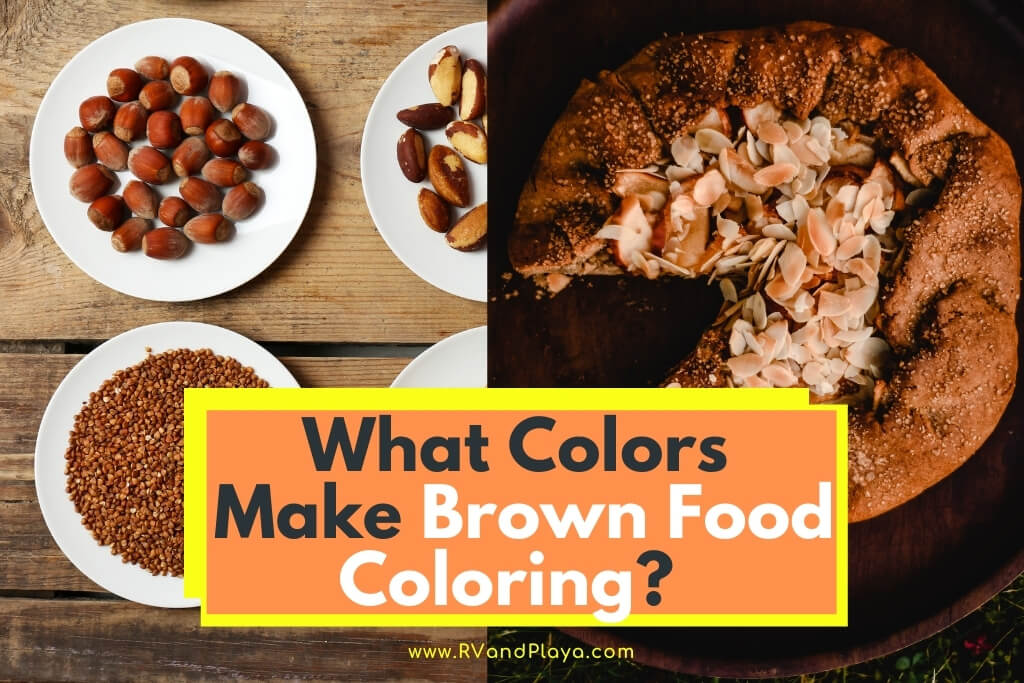When you think of the color brown, you don’t necessarily consider all of the color variations because, well, brown is brown.
It just doesn’t have the kind of pop you expect from vibrant reds and cool blues. Of course, that isn’t true and it’s easy to make brown with only two colors.
So, what colors make brown food coloring? Brown is a combination of the color red and the color green at an exact 1:1 ratio. If you’re just looking for the standard, run-of-the-mill brown, the story ends here, however, there are many shades of brown and more than one way to make them.
While brown isn’t the most popular, go-to choice for food coloring, it does have its appeal and is a favorite color for some people.
You can also experiment with different shades of brown by reducing or increasing the red/green ratio of food coloring drops.
Table of Contents
Different Ways To Make Brown Food Coloring
The traditional and obvious choice is to use food coloring and adding an equal amount of red and green drops until you have a strong enough brown for whatever you’re mixing.
The more drops you add—maintaining a 1:1 ratio—the more the brown will fill out and mix well with your project.
You can also make brown food coloring with beet juice and baking soda:
- Chop up several beets and place them in a pot.
- Pour water over them until the chunks are covered.
- Raise the heat until it’s barely enough to boil and let it simmer until the water is good and red.
- Remove the beet chunks that you cut up.
- Add a tablespoon or two of baking soda, mix it in, and return the heat to simmer.
- After it simmers for a while, the mixture will turn brown.
While this method won’t make an outstanding dye—if you’re looking to dye eggs—it’s excellent for anything else that you would want to use brown food coloring for.
Read also: What Colors Make Red Food Coloring?
If you don’t need a liquid, brown food coloring and just need to turn a mixed brown, there are additional alternatives that are pretty simple.
- Cocoa Powder: Cocoa powder is an excellent alternative to using a liquid food coloring as it will turn any light-colored mix into a standard brown color.
- Espresso Powder: Same as the cocoa powder, however, use it in a limited capacity.
- Charcoal Powder: This is another great option for achieving a brown color in a particular mix. Charcoal powder is safe to consume and won’t affect the taste much, if at all.
How to make brown color | Color mixing >> Check out the video below:
Making Different Shades Of Brown
You can make different shades of brown by experimenting with the ratio of food color drops that you use as well as adding in other colors to lighten or darken the overall effect.
Light Brown
Depending on the size of the overall mixture, add just a small amount of red and green, perhaps 5 drops each. Mix it together to see the result.
It’s important to start small and work your way up. Too little will produce a very light brown, while too much will make it darker than you wish.
If it’s not as dark as you want it to be, add a few more drops each of red and green. You don’t have to mix the red and green beforehand, as they’ll mix together regardless.
Deep Brown
You’ll want to add a little bit of blue with the red and green food coloring, with a lot more drops of both red and green.
You’ll want three drops of blue for every 40 drops of green and red. Start with 40 each of red and green, then add three drops of blue.
If you want to darken it, add ten more drops of red and green with only one drop of blue. Depending on how large the mixture is, continue repeating the process of 10:10:3 until you reach your goal.
Read also: What Colors Make Yellow Food Coloring?
Semi-Dark Chocolate Color
You’re basically doing the same thing as you did to make the deep brown coloring except you will triple everything.
This is especially good for much larger mixtures but may end up using a lot of extra food coloring.
Try 120 drops of red, 120 drops of green, and about 10 drops of blue. You can increase the blue a little bit, but not much.
Too much blue will start to throw the coloring off and you don’t want to end up ruining your project by going overboard on the blue.
Last But Not Least
No matter how much food coloring you need, whether you use natural ingredients or artificial food coloring, start small and finish big.
If you’re baking something and need to get the mixture just right, it’s really important to start with a little bit of each coloring.
Remember, you can fix an amount of food coloring that’s not enough, you can’t, however, fix it when it has become too much.
Here are some of my favorite services, products, and Stores
There are affiliate links, so if you do decide to use any of them, I´ll earn a small commission. But in all honesty, these are the exact what I use and recommend to everyone, even my own family.
To see all my of most up-to-date recommendations, check out this resource that I made for you!
+ Products & Services
+ Convenience Stores
+ Save Thousands of Dollars
References
https://www.webstaurantstore.com/blog/3696/natural-food-coloring.html
Recent Posts
Have you ever wondered what colors make green food coloring? How to Make Green Food Coloring? Look no more. We´ve got you covered. The process of baking a cake can be complex in of itself,...
Ever tried to make red icing before? If you answered yes, then you know how frustrating it can be. You drop in the coloring, and no matter how much you put in, you keep coming up with pink, right?...


